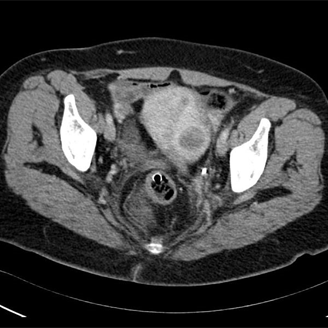Hysterectomy Technique May Spread Uterine Cancer
Researchers found that uterine cancers were present in 27 per 10,000 women undergoing morcellation, which fragments the uterus and can spread cancer cells.
Uterine fibroid on CT; source: Rádiológ, Wikimedia Commons.

In a study published in JAMA, researchers found that uterine cancers were present in 27 per 10,000 women undergoing hysterectomies using a minimally invasive procedure called electric power morcellation, which fragments the uterus into small pieces and can spread previously undetected uterine cancer cells.
This new evidence adds strength to arguments that doctors should be extremely cautious about using a procedure, which is performed on about 50,000 women a year, due to the risk that it may spread cancer.
Electric power morcellators have been used for 20 years. According to Jason D. Wright, MD, of the Columbia University College of Physicians and Surgeons in New York, and study co-authors, accurate statistics of the prevalence of malignancies among women who undergo the procedure have been lacking. In the current study, the researchers used the Perspective database, consisting of insurance information on more than 500 hospitals and encompassing about 15% of all hospitalizations, to identify women who underwent the procedure between 2006 and 2012. Most of the hospitals within the database are teaching hospitals in the southern part of the United States.
Of the 232,882 women who had a minimally invasive hysterectomy, morcellation was performed on 15.7% of the women (36,470 cases). Among those women who underwent the morcellation technique, 99 cases of uterine cancer were identified during the procedure (prevalence of 27 out of 10,000).
In addition to uterine cancer, 26 cases of other gynecologic malignancies, 39 uterine neoplasms, and 368 cases of endometrial hyperplasia were detected.
“Prevalence information is the first step in determining the risk of spreading cancer with morcellation,” write the authors in their discussion. “Although data are limited, women with apparent uterine-confined neoplasms at the time of morcellation have been found to have intraperitoneal tumor dissemination at the time of reexploration.”
The prevalence ratio of a uterine malignancy increased with increasing age, from 4.97 (women 50 to 54), to 19.37 (women 55 and 59), and to 35.97 (women older than 65).
“Patients considering morcellation should be adequately counseled about the prevalence of cancerous and precancerous conditions prior to undergoing the procedure,” conclude the authors.
Still, longer term follow-up of these women who had a uterine cancer detected at the time of their morcellation procedure is needed to understand the outcomes of these cancers and the potential pathology of the detected abnormalities.
In April, the US Food and Drug Administration (FDA) issued a notice stating that the agency “discourages use of laparoscopic power morcellation for removal of uterus or uterine fibroids,” because based on available data the surgical procedure “poses risk of spreading undetected cancerous tissue in women with unsuspected cancer.”
The FDA is convening a public meeting of the Obstetrics and Gynecological Medical Devices Panel to further discuss the data and use of the morcellation procedure. In the meantime, the agency notes that other treatments, including minimally invasive surgery, such as traditional surgical vaginal or abdominal hysterectomy and myomectomy, and laparoscopic hysterectomy and myomectomy without morcellation are valid options, as are non-surgical ones.